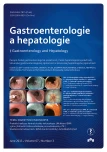Quality control of colonoscopy in daily practice – experience from Beskydy Gastrocentre
Authors:
I. Mikoviny Kajzrlíková 1; P. Vítek 1,2; J. Chalupa 1; J. Kuchař 1; J. Platoš 1; P. Řeha 1
Authors‘ workplace:
Beskydské Gastrocentrum, Interní oddělení, Nemocnice ve Frýdku-Místku, p. o.
1; Katedra interních oborů, LF OU v Ostravě
2
Published in:
Gastroent Hepatol 2013; 67(3): 183-187
Category:
Digestive Endoscopy: Original Article
Overview
Quality control of colonoscopy is indispensable for every endoscopy unit. The most important quality indicators include adenoma detection rate (ADR) or polyp detection rate (PDR), caecal intubation rate and procedure complications. The aim of our paper is to introduce the methodology and results of quality control in our endoscopy unit in 2012.
Methods:
The data from all examinations are recorded in a database of colonoscopy in MS Excel. The main parts of the database comprise data about the endoscopist, epidemiologic data about the patient (sex, age, antiplatelet and anticoagulation therapy, family history of colorectal cancer), data about the procedure (type, indication, sedation, bowel preparation, caecal intubation, ileal intubation, number of lesions, histology) and complications. A trained endoscopic nurse records histologic results separately. Quality parameters are evaluated every three months by a gastroenterologist and they are evaluated both for the endoscopy unit and for every endoscopist separately.
Results:
From January to December 2012 194 sigmoideoscopies and 1,675 colonoscopies were performed, out of which 299 (18%) were screening colonoscopies. Intersubject variability of ADR for the endoscopists involved was 40–65%.
Conclusions:
Monitoring of basic quality parameters in the endoscopy unit including ADR is feasible. Intersubject variability of ADR among the endoscopists in our unit is relatively low.
Keywords:
colonoscopy – quality control – adenoma
Sources
1. Jover R, Herráiz M, Alarcón O et al. Clinical practice guidelines: quality of colonoscopy in colorectal cancer screening. Endoscopy 2012; 44(4): 444–451.
2. Kajzrlíková IM, Vítek P. Endoskopická polypektomie – jak dosáhnout standardu kvality v roce 2012? Gastroent Hepatol 2012; 66(4): 294–297.
3. Rembacken B, Hassan C, Riemann JF et al. Quality in screening colonoscopy: position statement of the European Society of Gastrointestinal Endoscopy (ESGE). Endoscopy 2012; 44(10): 957–968.
4. Barclay RL, Vicari JJ, Doughty AS et al. Colonoscopic withdrawal times and adenoma detection during screening colonoscopy. N Engl J Med 2006; 355(24): 2533–2541.
5. Lee TJ, Rutter MD, Blanks RG et al. Colonoscopy quality measures: experience from the NHS Bowel Cancer Screening Programme. Gut 2011; 61(7): 1050–1057.
6. De Wijkerslooth TR, Stoop EM, Bossuyt PM et al. Differences in proximal serrated polyp detection among endoscopists are associated with variability in withdrawal time. Gastrointest Endosc 2013; 77(4): 617–623.
7. Winawer SJ, Zauber AG, Ho MN et al. Prevention of colorectal cancer by colonoscopic polypectomy. The National Polyp Study Workgroup. N Engl J Med 1993; 329(27): 1977–1981.
8. Rex DK. Colonoscopy. Gastrointest Endosc Clin N Am 2000; 10(1): 135–160.
9. Kaminski MF, Regula J, Kraszewska E et al. Quality indicators for colonoscopy and the risk of interval cancer. N Engl J Med 2010; 362(19): 1795–1803.
10. Rex DK, Bond JH, Winawer S et al. Quality in the technical performance of colonoscopy and the continuous quality improvement process for colonoscopy: recommendations of the U.S. Multi-Society Task Force on Colorectal Cancer. Am J Gastroenterol 2002; 97(6): 1296–1308.
11. Coe SG, Wallace MB. Assessment of adenoma detection rate benchmarks in women versus men. Gastrointest Endosc 2013; 77(4): 631–635.
12. Kessler WR, Imperiale TF, Klein RW et al. A quantitative assessment of the risks and cost savings of forgoing histologic examination of diminutive polyps. Endoscopy 2011; 43(8): 683–691.
13. Denis B, Bottlaender J, Weiss AM et al. Some diminutive colorectal polyps can be removed and discarded without pathological examination. Endoscopy 2011; 43(2): 81–86.
14. Williams JE, Holub JL, Faigel DO. Polypectomy rate is a valid quality measure for colonoscopy: results from a national endoscopy database. Gastrointest Endosc 2012; 75(3): 576–582.
15. Wilkins T, LeClair B, Šmolkin M et al. Screening colonoscopies by primary care physicians: a meta-analysis. Ann Fam Med 2009; 7(1): 56–62.
16. Falt P, Liberda M, Smajstrla V et al. Combination of water immersion and carbon dioxide insufflation for minimal sedation colonoscopy: a prospective, randomized, single-center trial. Eur J Gastroenterol Hepatol 2012; 24(8): 971–977.
17. Falt P, Liberda M, Šmajstrla V et al. Snížení dyskomfortu spojeného s kolonoskopií použitím kombinace vodní imerze a insuflace oxidu uhličitého. Gastroent Hepatol 2012; 66(3): 175–182.
18. Falt P, Šmajstrla V, Fojtík P et al. Cap-assisted water immersion colonoscopy for minimal sedation colonoscopy – a prospective, randomized, single-center trial. Dig Endosc 2012. doi: 10.1111//j.1443–1661. 2012.01402.x
19. Urban O, Kijonkova B, Kajzrlíková IM et al. Local residual neoplasia after endoscopic treatment of laterally spreading tumors during 15 months of follow-up. Eur J Gastroenterol Hepatol 2013; 25(6): 733–738.
Labels
Paediatric gastroenterology Gastroenterology and hepatology SurgeryArticle was published in
Gastroenterology and Hepatology

2013 Issue 3
Most read in this issue
- Faecal incontinence
- Asacol 800™ mg tablets
- Current position and future trends of therapy in ulcerative colitis
- Health risks of endoscopy for endoscopists in the Czech Republic – a pilot study
